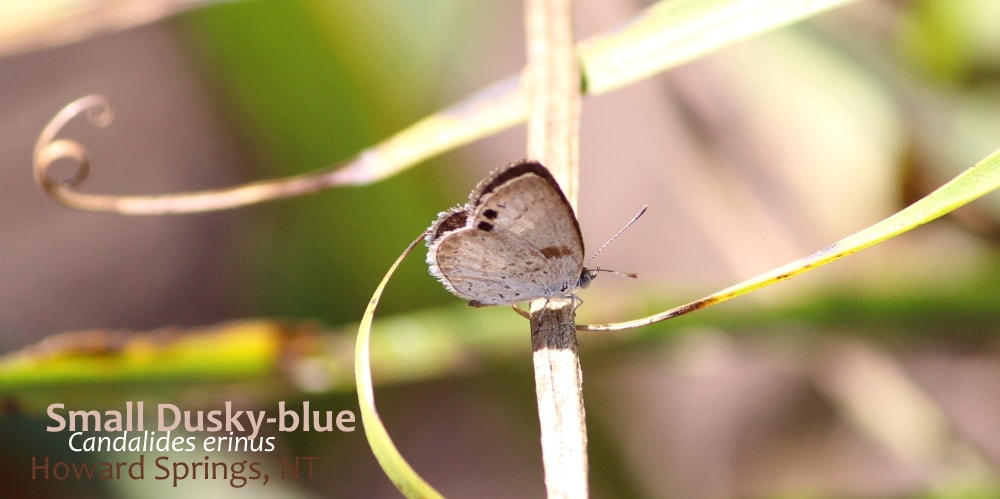How to learn about butterflies.
..
Have a look at all the butterflies we saw on 2019 Northern Territory trips here on iNaturalist: https://www.inaturalist.org/projects/top-end-2019-invertebrates
..
NYMPHS – BROWNS – Nymphalidae
The Nymphs are a large group of elegant, long-winged butterflies patterned in orange, black and brown. A few have some blue on their wings. Most have white and blue reflective eye-spots (ocelli) in their wings that are very helpful for identification – in fact if a butterfly has prominent eye-spots it is probably a nymph*.
Read why scientists believe that butterflies have eye-spots.
These butterflies are usually pretty large and quite showy, so they tend to be the ones most photographed.
Learn more about Australian nymph butterflies at this excellent site: http://lepidoptera.butterflyhouse.com.au/nymp/nymphalidae.html
*Note: some Blues also have eyespots, but they tend to be a simple black spot surrounded by orange, and are less prominent than the nymphs’.
..
Orange Ringlet Hypocysta adiante

This Northern Territory butterfly is seen very frequently in most of the habitats we visit.
Distribution: Top End (mostly NT) and coastal Queensland & NSW
Habitat: Open and savanna woodland
Caterpillar food plant: Grasses Poaceae usually Themeda triandra
..
Blue Argus Junonia orithya

A little stunner!
Distribution: Top End and coastal Queensland.
Habitat: Savannah woodland – the dominant habitat in the Top End of the Northern Territory.
Caterpillar food plants: Blue Trumpet Brunoniella; Hygrophila (an aquatic plant); Hypoestes & Justicia; Pseuderanthemum; Rostellularia; Angelonia; Buchnera and Striga (all small herbs with white to purple flowers)
..
Dingy Bush-brown Mycalesis perseus

A common, often-seen butterfly. The name is a bit unfair – they are delicately lovely. The wet season form is a bit more showy than this dry season version.
Distribution: this butterfly occurs mostly in coastal Queensland, with a small distribution in Top End of the Northern Territory
Habitat: wide variety, especially savanna woodland
Caterpillar food plants: Kangaroo Grass Themeda triandra, Queensland Blue Grass Dichanthium sericeum and Giant Spear-grass Heteropogon triticeus.
..
Cedar Bush-brown Mycalesis sirius

Seen less often than the Dingy Bush-brown, this butterfly is much richer red in colour.
Distribution: a small area of the Northern Territory near Darwin & Kakadu, coastal Queensland. Range has reduced due to loss of very specific habitat.
Habitat: Paperbark gallery forests.
Caterpillar food plants: Southern Grass Ischaemum australe. Sometimes also Kangaroo Grass Themeda triandra.
..
BLUES – LYCAENIDS – Lycaenidae
Usually smaller than nymphs, but often so beautiful that they catch the eye. Many blues have a blue or purple upperwing, and a brown camouflaged underwing. A few are white, yellow, black & brown and could pass for Pieridae (Whites-Yellows), but some have a tailed or tasseled edge to their lower/hind wing (tornus) – which Australian Pieridae never have. A few have brown & orange wings and look superficially like nymphs, but with no eyespots.
Basically, if a butterfly can’t be found in the first, most obvious group, look for it in the Blues.
..
Small Dusky-Blue Candalides erinus

Unfortunately I couldn’t capture the lovely upperwing colour of this butterfly.
Distribution: Top End
Habitat: Coastal heathland, paperbark swamps and savannah woodland not far from the coast.
Caterpillar food plants: Dodder Laurel Cassytha capillaris
..,
Tailess Line-Blue / Purple Line-blue Prosotas dubiosa

This butterfly was so tiny it hid behind a blade of grass, but its beautiful purple-blue upperwing had caught my eye.
Distribution: Northern Territory western Top End, coastal Western Australia Top End, coastal Queensland.
Habitat: Savannah woodland
Caterpillar food plants: Flower buds and flowers of Cajanus reticulatus (a yellow-flowered pea), Wattles Acacia species and Tuckeroo Cupaniopsis anacardioides.
..
Some blues are very tiny and difficult to identify, like this little beauty.

..
WHITES, YELLOWS & SULPHURS – Pieridae
Mostly small or medium-sized Northern Territory butterflies, predominantly white or yellow, many with black or brown edging to their wings. A few have splashes of red.
Grass-yellows are very common in the Northern Territory Top End. They are noticeable because they fly close to the ground in most of the habitats we visit. Jezebels are large and showy and we often find them when we are looking for honeyeater birds in the canopies of flowering trees.
..
Large / Common Grass-yellow Eurema hecabe

Distribution: Top End
Habitat: Savannah woodland and open country
Caterpillar food plants: Shrubs: Cassia, Senna, Breynia, Indigoes Indigofera and Wattles Acacia species.
..
Scarlet Jezebel Delias argenthona

Distribution: Top End of Northern Territory and Western Australia; coastal Queensland & NSW.
Habitat: Savannah woodlands and paperbark gallery forests.
Caterpillar food plants: Mistletoes: Amyema, Dendrophthoe, Decaisnina signata, Diplatia furcata, and also Northern Sandalwood Santalum lanceolatum.
..
Join us in June, July, August, September or October in the Northern Territory Top End – Wild Top End share tour runs on dates in August and September, Maximum Wildlife private tours available any time between June and October.
We also love to see Dragonflies in the Top End – read more here.
..
NOTES & REFERENCES:
Identification and notes from
Braby, Michael F. (2009) “The Complete Field Guide to Butterflies of Australia” CSIRO Publishing. https://www.publish.csiro.au/book/7223/
Excellent comprehensive information on all Australian butterflies and their caterpillars here: http://lepidoptera.butterflyhouse.com.au/

